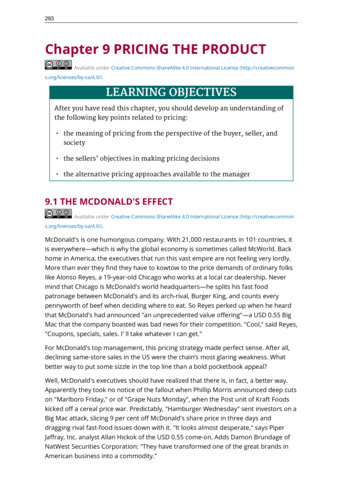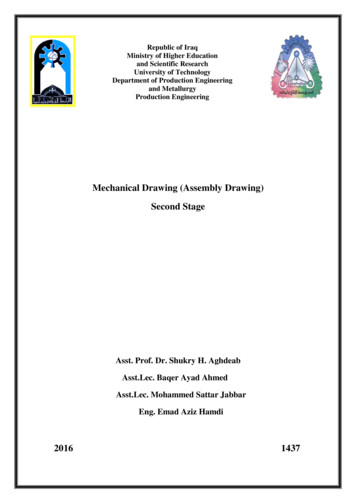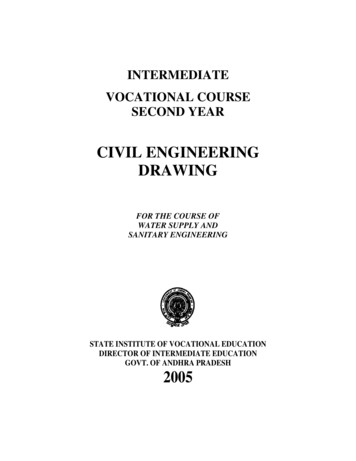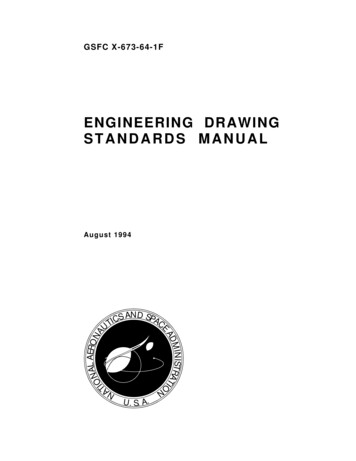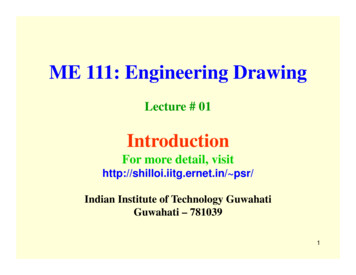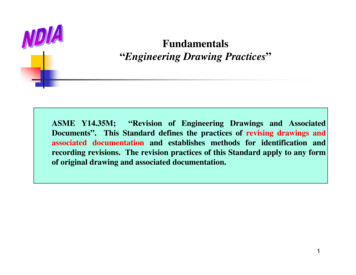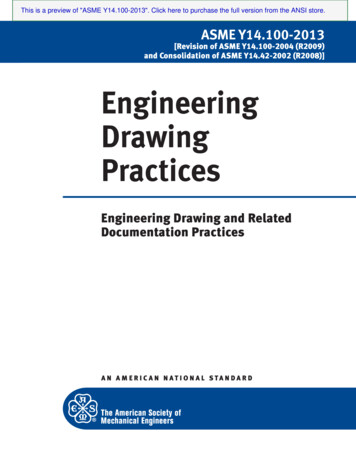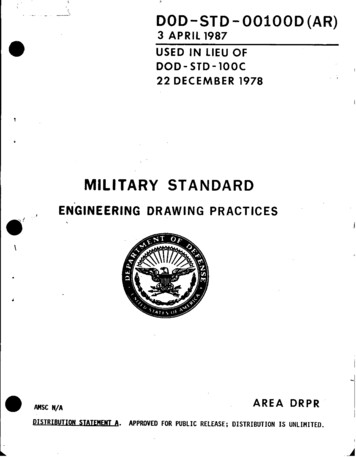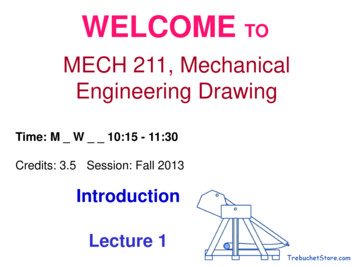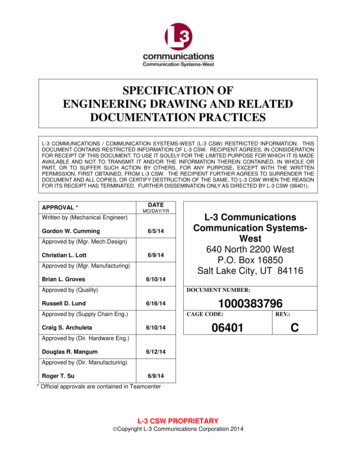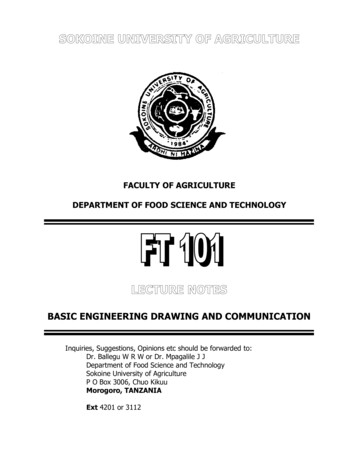
Transcription
SOKOINE UNIVERSITY OF AGRICULTUREFACULTY OF AGRICULTUREDEPARTMENT OF FOOD SCIENCE AND TECHNOLOGYLECTURE NOTESBASIC ENGINEERING DRAWING AND COMMUNICATIONInquiries, Suggestions, Opinions etc should be forwarded to:Dr. Ballegu W R W or Dr. Mpagalile J JDepartment of Food Science and TechnologySokoine University of AgricultureP O Box 3006, Chuo KikuuMorogoro, TANZANIAExt 4201 or 3112
FT 101: 2 Credit Hours: ( 30 Lect. hrs : 0 Sem. hrs : 60 Pract. hrs )Prerequisite: NoneInstructors:Dr. J J MpagalileDr. W R W Ballegu(Mobile: 0754 463 016 ; E-Mail: wballegu@suanet.ac.tz)Department of Food Science and Technology, SUA.Objective:To equip students with basic skills required in engineering drawings, electrical circuitdiagrams, and communication.CourseContents:Purpose and forms of communication; technical communication, report writing, drawing,reprographics, engineering drawing, sketching, pictorial projections, paper sizes, scales,conventions in layout, lettering and representation of components, tolerances, assemblydrawings, K-parts list, exercises in machine drawings, structural drawings and design.Selection of machine components such as; V-belts, flat-belts and pulleys. Simple stresscalculations for shafts and structural members.CourseThe Course Assessment (culminating toAssessment: following four components;(i)Weekly Practical Reports(ii)Practical Tests(iii)Theory Tests(iv)End of Semester ExaminationBallegu, W R W and Mpagalile, J Jthe Final Grade), will be made up of the---------Page 2 of 3020%20%20%40%FT 101
COURSE OUTLINE1.1Purpose and Forms of Communication PAGE5551.2Technical Communication 1.2.1 Standardization .1.2.2 Technical Report Writing .1.2.3 Pictorial Communication .5567Part – 2 :ENGINEERING DRAWING .72.1Presentation of Engineering (Technical) Drawings .2.1.1 Axonometric (Pictorial) Projections .Dimetric Projection .Isometric Projection . .2.1.2 Orthographic Projections Naming of Views .Standard Orthographic Projections .888999102.2Standards .2.2.1 Paper Sizes and Folding 2.2.2 Scales 2.2.3 Lines and Lettering .2.2.4 Title Block and Parts List 12121314162.3Preparing Engineering Drawings 2.3.1 Sketches .2.3.2 Hand drafts 2.3.3 Detail (Working) Drawings .171718182.4Preparing Detail Drawings 2.4.1 Some Basic Instruments and Equipment . 2.4.2 General Guidelines .Spacing of Views Projection of Views .2.4.3 Sectioning .2.4.4 Dimensioning .Functional Dimensions .Non-Functional Dimensions .Auxiliary Dimensions .2.4.5 Some Special Features .Threaded Parts .Machines Holes (Drilled and Milled holes) .Chamfers and Countersinks Specially Treated Surfaces .2.4.6 Tolerances and Fits 181820202122232323232525262727272.5Assembly Drawings 29Part – 3:EXERCISES .30REFERENCES . .4Part – 1:COMMUNICATION .Ballegu, W R W and Mpagalile, J JPage 3 of 30FT 101
REFERENCES1. STIRLING, N. (1989): An Introduction to Technical Drawing – Metric EditionDelmar Publishers. Albany, New York, pp. 3702. BHANDARI, V.K., BUEHLMANN, E.T., KELLER, U., OEHNINGER, J. and TOMESEN, L.B.M. (1983):Drawing and Design: Data Book for Mechanical Engineering3. SHIGLEY, J.E. (1977): Mechanical Engineering DesignMcGraw-Hill, Kogakusho Ltd, Tokyo4. ORLOV, P. (1979): Fundamentals of Mechanical Design – Vol. 1 – 5MIR Publishers, Moscow5. FRENCH, T.E. and VIERCK, C.J. (1966): Fundamentals of Engineering Drawing – 2nd Edition6. GIERSECKE, F.E., MITCHELL, A., SPENCER, H.C., HILL, I.L. and DYGDON, J.T. (1986):Technical Drawing – 8th Edition7. Any other Relevant Standard(s)e.g.BS 303:164 Engineering Drawing PracticeWestermann Tables for the Metal TradeBS 3763 The International System of Units (SI) etc.Ballegu, W R W and Mpagalile, J JPage 4 of 30FT 101
Part – 1:Definition:1.1COMMUNICATIONCommunication is defined as, “the act of communicating, that is, passing on news,information, feelings etc.” (Oxford Students’ Dictionary of Current English – 1985)Purpose and Forms of CommunicationThe purpose of communication – irrespective of the form/means in which it is conveyed – is to pass amessage from one entity (a person or group of people) to another entity (person or group) in the mostconvenient way and with minimum distortion or ambiguity.The two main forms of communication are through audio and visual means. Audio means rely onsound signals that are perceived by ears. Sound producing/receiving devices are used for this purpose.Visual means on the other hand, depend on light signals (images) that are perceived by eyes. Imageproducing/receiving devices are used for this purpose. This may include things like text, drawings,figures, photographs, video images, TV images, images of real objects etc. Other human senses aresometimes used for communication (e.g. a touch to attract attention, braille text for the blind, etc).1.2Technical CommunicationTechnical communication is an advanced form of communication whereby people of the same trade(profession) can convey messages to one another more accurately and precisely. To achieve this, atechnical language, which is well standardized, is needed (e.g. botanical names for plant scientists, tion is the process of formulating and applying rules for an orderlyapproach to a specific activity for the benefit and with the cooperation of all concerned,and in particular for the promotion of optimum overall economy taking due account offunctional conditions and safety requirements.”(ISO – International Organization for Standardization)Standards are set at different levels. There are local standards, national standards, regional standardsand international standards. Typical examples of the different levels of standards may include; Local Standards: SUA formats for writing various academic reports, Morogoro Municipalstandards for waste disposal, grading of product quality in an industry, etc. National Standards: All TBS standards, standards set by local professional bodies e.g. theEngineers’ Registration Board (ERB), DIN (German), BS (U.K.), GOST (U.S.S.R.), etc. Regional Standards: Standards set for the East African Community, standards for the SADCregion, even the AU can set standards for her member states, etc. International Standards: ISO (International Organization for Standardization)DIN – an internationally accepted German national standardBS – an internationally accepted British national standardIt is always desirable to adhere to international standards, particularly the ISO standards that employ SIunits. Standardization serves five main objectives; Creation of uniform terminology Maintenance of a limited order of variety Specification of functional uses and limitations Establishment of unambiguous objective test methods and material specification Conduction of comparative studies of various standardsBallegu, W R W and Mpagalile, J JPage 5 of 30FT 101
1.2.2Technical Report WritingReports are written in accordance to accepted standards (formats). There are some minimumrequirements, which the report has to satisfy for it to be accepted. In any report, a minimum number ofwords – which sufficiently presents the message accurately and precisely – is needed.Requirements for different reports vary. For instance, educational reports (e.g. laboratory practicalreports), reports for seminars and workshops, research reports, research findings for publication inreputed scientific Journals, etc. Despite the many variations in the formats of reports, almost always atechnical report consists of the following parts; Abstract, Introduction, Literature Review, Materials andMethods, Experimental Setup, Results, Discussion (often times, the results are combined withdiscussions), Conclusions and Recommendations, References and Appendices. It must be noted thatthis is only a general guideline and not a “strict biblical command”. In real life, there is likely to be someminor (or even major) variations. As a rule of thumb, any technical report must be styled and detailed tofocus on the intended reader(s). For instance, a report intended for a village meeting will differsignificantly in style and level of detail from a research paper intended for publication in a scientificJournal.o AbstractThis is a brief summary (150 – 300 words) of the work being reported. It is simply a synopsis ofwhat was done, why, how, the main findings, the main conclusions and/or recommendations.Although the abstract appears first in the report, it is usually written last after everything hasbeen put in place. Usually this is the most difficult part of the report to write, as it has to reflectin a nutshell the rest of the report!o IntroductionThis is the background information (briefly) justifying the work being reported. It is a synopsisof what has been done prior to the present work (reference to the literature), strengths andweaknesses of the methods used in the past and what has been done in the present work thatdistinguishes it from the past works.o Literature ReviewThis presents a detailed coverage of what others have done that is closely related to the presentstudy. This has to reflect the scope of knowledge (most updated) that is reported in theliterature related to the work being reported in the present study. It forms a sound basis formeaningful interpretation of the results obtained in the present study.oMaterials and Methods (Methodology)The materials used (sources and quality/grade), methods used (briefly explain each method indetail to enable the reader to replicate your work, if deemed necessary. For standard methods,make reference to the standard(s) concerned (e.g. AACC------), a brief account of how nonstandard experiments were done is usually necessary.oResults and DiscussionThis part is normally presented in tabular and/or graphical forms. It is a brief discussion of mainfindings based on the results obtained and experience of other workers (literature). Sometimesthe results are presented separate from the discussion.oConclusions and/or RecommendationsYour personal inferences regarding the results, your recommendations for further work, etc. Youshould be honest and admit main weaknesses that might have affected the results obtained inyour reported work (i.e. main sources of error – if any).ReferencesoBallegu, W R W and Mpagalile, J JPage 6 of 30FT 101
All sources of information cited in the literature review and elsewhere. Avoid including generalreading materials that were used to obtain a general background on the subject matter.o AppendicesAny relevant information, which you strongly feel is necessary for the wholesomeness of thereport, but which could not be conveniently fitted into the bulk of the report.1.2.3Pictorial CommunicationPictorial communication includes drawings and photographs. Drawings and photographs, whereappropriate, convey the message more accurately than a passage of words. Photographs are moreaccurate and sometimes the true colors of the object are displayed. However, photographs areexpensive, less informative and their magnification is limited in terms of clarity. On the other hand,drawings are cheap, clearer and easy to understand. They are therefore, in most cases, more preferredthan photographs.Part – 2:ENGINEERING DRAWINGWhy Engineering Drawing?As a Food Scientist and Technologist, you will inevitably be required to communicate with differentpeople for different reasons. In some situations, communications will be sufficiently taken care of by useof plain text. However in other situations, text alone may not suffice and a more specialized form ofcommunication (technical/engineering drawing) may prove irreplaceably ersSpare partsManufacturersDrawing (just like photography) is one of the basic forms of visual communication. Drawing is used torecord objects and actions of everyday life in an easily recognizable manner. There are two major typesof drawings: artistic drawings and technical drawings.Ballegu, W R W and Mpagalile, J JPage 7 of 30FT 101
Artistic DrawingsThese are a form of freehand representation that makes use of pictures to provide a general impressionof the object being drawn. There are no hard rules or standards in the preparation of artistic drawings.They are simply drawn by artists, based more or less on one’s talent and skills. Although these drawingsare often very attractive, they find very limited use in the world of science.Technical DrawingsThese are detailed drawings drawn accurately and precisely. They are pictures that have been preparedwith the aid of mathematical instruments in order to record and transmit technical information. Theyprovide an exact and complete description of things that are to be built or manufactured.o Technical drawings do not portray the objects the way they directly appear to the eyeo They make use of many specialized symbols and conventions in order to transmit technicalinformation clearly and exactly.o To understand and correctly interpret technical drawings, one needs to acquaint oneself withthe fundamentals of technical drawing – hence the purpose of this course.2.1Presentation of Engineering (Technical) Drawings2.1.1Axonometric (Pictorial) ProjectionsThese are drawings in which the object is drawn in three dimensions (3-D), i.e. three sides of the objectappe
communication (technical/engineering drawing) may prove irreplaceably useful. Drawing (just like photography) is one of the basic forms of visual communication. Drawing is used to record objects and actions of everyday life in an easily recognizable manner. There are two major types of drawings: artistic drawings and technical drawings.File Size: 386KBPage Count: 30
